NISSAN QUEST 2005 V42 / 3.G Service Manual
Manufacturer: NISSAN, Model Year: 2005, Model line: QUEST, Model: NISSAN QUEST 2005 V42 / 3.GPages: 328, PDF Size: 5.75 MB
Page 41 of 328
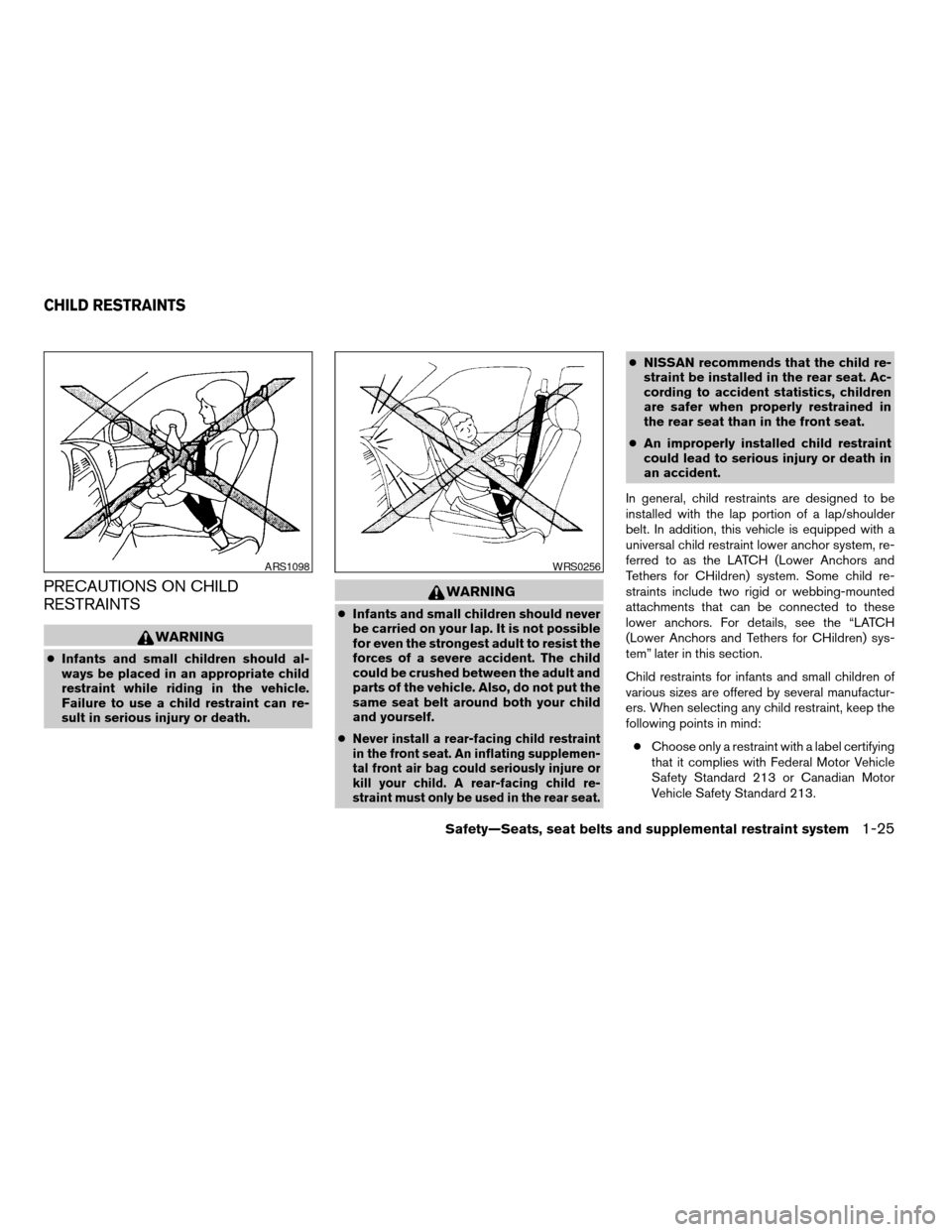
PRECAUTIONS ON CHILD
RESTRAINTS
WARNING
cInfants and small children should al-
ways be placed in an appropriate child
restraint while riding in the vehicle.
Failure to use a child restraint can re-
sult in serious injury or death.
WARNING
cInfants and small children should never
be carried on your lap. It is not possible
for even the strongest adult to resist the
forces of a severe accident. The child
could be crushed between the adult and
parts of the vehicle. Also, do not put the
same seat belt around both your child
and yourself.
c
Never install a rear-facing child restraint
in the front seat. An inflating supplemen-
tal front air bag could seriously injure or
kill your child. A rear-facing child re-
straint must only be used in the rear seat.
cNISSAN recommends that the child re-
straint be installed in the rear seat. Ac-
cording to accident statistics, children
are safer when properly restrained in
the rear seat than in the front seat.
cAn improperly installed child restraint
could lead to serious injury or death in
an accident.
In general, child restraints are designed to be
installed with the lap portion of a lap/shoulder
belt. In addition, this vehicle is equipped with a
universal child restraint lower anchor system, re-
ferred to as the LATCH (Lower Anchors and
Tethers for CHildren) system. Some child re-
straints include two rigid or webbing-mounted
attachments that can be connected to these
lower anchors. For details, see the “LATCH
(Lower Anchors and Tethers for CHildren) sys-
tem” later in this section.
Child restraints for infants and small children of
various sizes are offered by several manufactur-
ers. When selecting any child restraint, keep the
following points in mind:
cChoose only a restraint with a label certifying
that it complies with Federal Motor Vehicle
Safety Standard 213 or Canadian Motor
Vehicle Safety Standard 213.
ARS1098WRS0256
CHILD RESTRAINTS
Safety—Seats, seat belts and supplemental restraint system1-25
ZREVIEW COPYÐ2005 Quest(van)
Owners ManualÐUSA_English(nna)
07/20/04Ðdebbie
X
Page 42 of 328
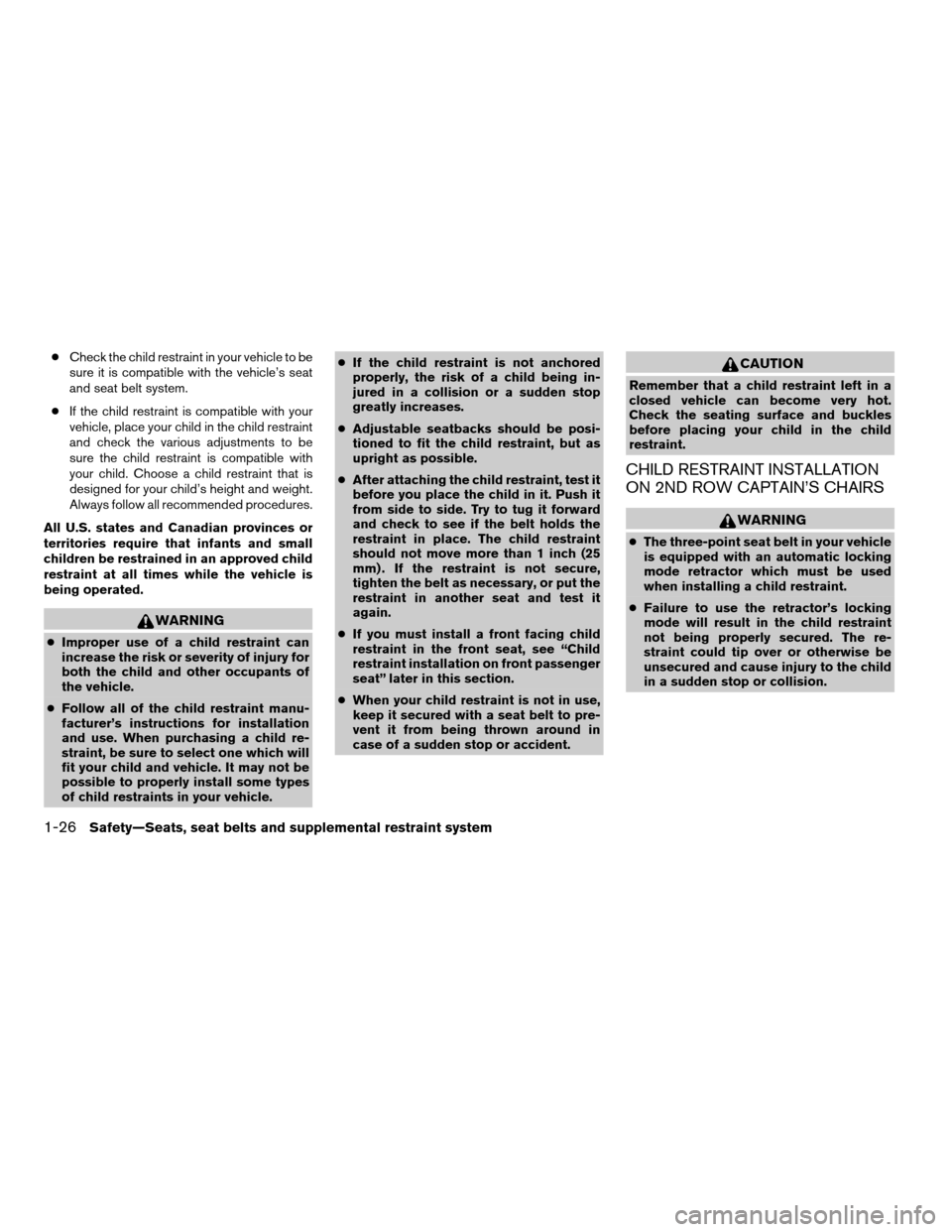
cCheck the child restraint in your vehicle to be
sure it is compatible with the vehicle’s seat
and seat belt system.
cIf the child restraint is compatible with your
vehicle, place your child in the child restraint
and check the various adjustments to be
sure the child restraint is compatible with
your child. Choose a child restraint that is
designed for your child’s height and weight.
Always follow all recommended procedures.
All U.S. states and Canadian provinces or
territories require that infants and small
children be restrained in an approved child
restraint at all times while the vehicle is
being operated.
WARNING
cImproper use of a child restraint can
increase the risk or severity of injury for
both the child and other occupants of
the vehicle.
cFollow all of the child restraint manu-
facturer’s instructions for installation
and use. When purchasing a child re-
straint, be sure to select one which will
fit your child and vehicle. It may not be
possible to properly install some types
of child restraints in your vehicle.cIf the child restraint is not anchored
properly, the risk of a child being in-
jured in a collision or a sudden stop
greatly increases.
cAdjustable seatbacks should be posi-
tioned to fit the child restraint, but as
upright as possible.
cAfter attaching the child restraint, test it
before you place the child in it. Push it
from side to side. Try to tug it forward
and check to see if the belt holds the
restraint in place. The child restraint
should not move more than 1 inch (25
mm) . If the restraint is not secure,
tighten the belt as necessary, or put the
restraint in another seat and test it
again.
cIf you must install a front facing child
restraint in the front seat, see “Child
restraint installation on front passenger
seat” later in this section.
cWhen your child restraint is not in use,
keep it secured with a seat belt to pre-
vent it from being thrown around in
case of a sudden stop or accident.
CAUTION
Remember that a child restraint left in a
closed vehicle can become very hot.
Check the seating surface and buckles
before placing your child in the child
restraint.
CHILD RESTRAINT INSTALLATION
ON 2ND ROW CAPTAIN’S CHAIRS
WARNING
cThe three-point seat belt in your vehicle
is equipped with an automatic locking
mode retractor which must be used
when installing a child restraint.
cFailure to use the retractor’s locking
mode will result in the child restraint
not being properly secured. The re-
straint could tip over or otherwise be
unsecured and cause injury to the child
in a sudden stop or collision.
1-26Safety—Seats, seat belts and supplemental restraint system
ZREVIEW COPYÐ2005 Quest(van)
Owners ManualÐUSA_English(nna)
07/20/04Ðdebbie
X
Page 43 of 328

Front facing
When you install a child restraint on the 2nd row
captain’s chairs, follow these steps:1. Position the child restraint on the seat. It can
be placed in a front facing direction, de-
pending on the size of the child. Adjust the
head restraint to its highest position. Always
follow the restraint manufacturer’s instruc-
tions. The back of the child restraint should
be secured against the vehicle seat back. If
necessary, adjust or remove the head re-
straint to obtain the correct child restraint fit.
See “Head restraint adjustment” earlier in
this section. If the head restraint is removed,
store it in a secure place. Be sure to install
the head restraint when the child restraint is
removed. If the seating position does not
have an adjustable head restraint and it is
interfering with the proper child restraint fit,
try another seating position or a different
child restraint.2. Route the seat belt tongue through the child
restraint and insert it into the buckle until you
hear and feel the latch engage.
Be sure to follow the child restraint manu-
facturer’s instructions for belt routing.
Front Facing — step 1
LRS0347
Front Facing — step 2
WRS0524
Safety—Seats, seat belts and supplemental restraint system1-27
ZREVIEW COPYÐ2005 Quest(van)
Owners ManualÐUSA_English(nna)
07/20/04Ðdebbie
X
Page 44 of 328
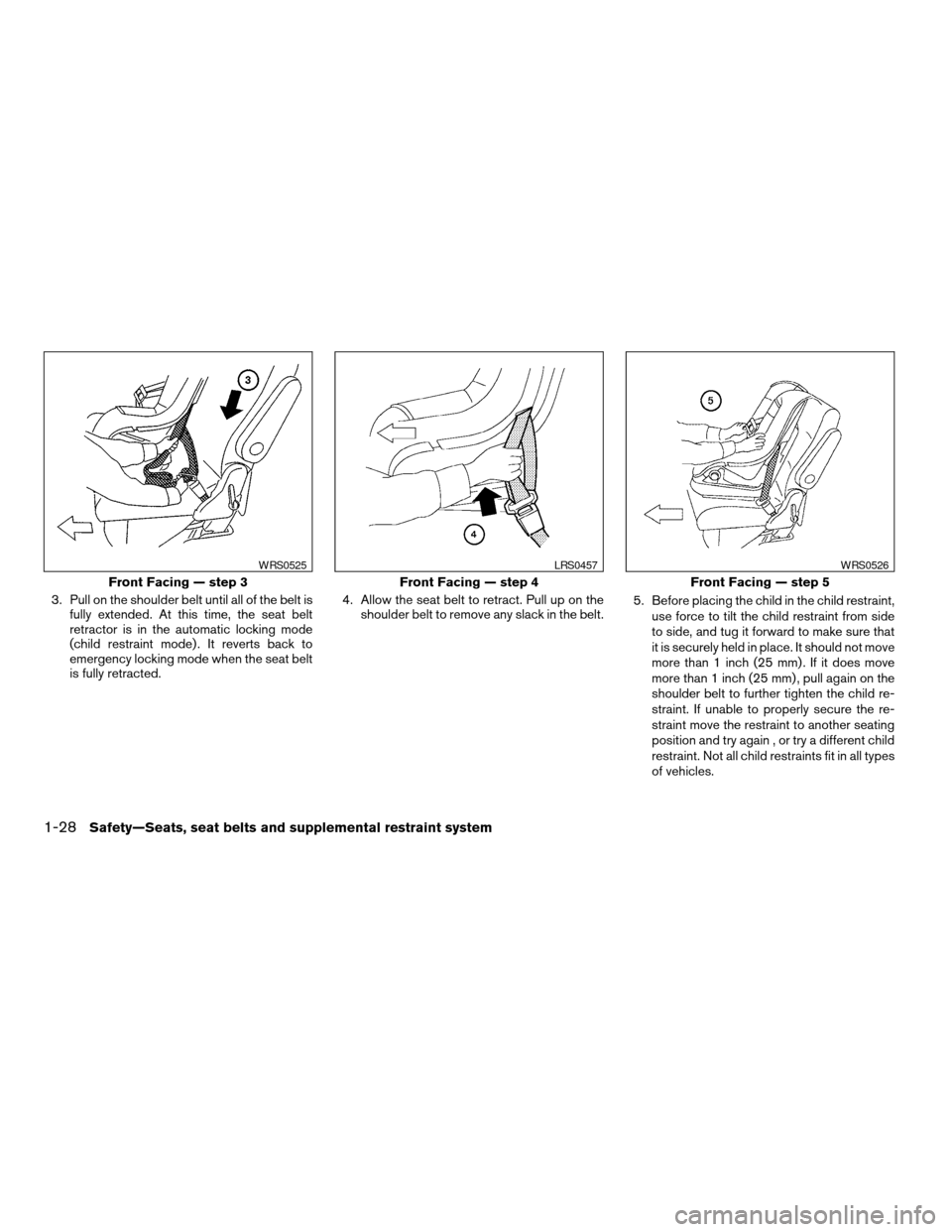
3. Pull on the shoulder belt until all of the belt is
fully extended. At this time, the seat belt
retractor is in the automatic locking mode
(child restraint mode) . It reverts back to
emergency locking mode when the seat belt
is fully retracted.4. Allow the seat belt to retract. Pull up on the
shoulder belt to remove any slack in the belt.5. Before placing the child in the child restraint,
use force to tilt the child restraint from side
to side, and tug it forward to make sure that
it is securely held in place. It should not move
more than 1 inch (25 mm) . If it does move
more than 1 inch (25 mm) , pull again on the
shoulder belt to further tighten the child re-
straint. If unable to properly secure the re-
straint move the restraint to another seating
position and try again , or try a different child
restraint. Not all child restraints fit in all types
of vehicles.
Front Facing — step 3
WRS0525
Front Facing — step 4
LRS0457
Front Facing — step 5
WRS0526
1-28Safety—Seats, seat belts and supplemental restraint system
ZREVIEW COPYÐ2005 Quest(van)
Owners ManualÐUSA_English(nna)
08/04/04Ðbetty
X
Page 45 of 328
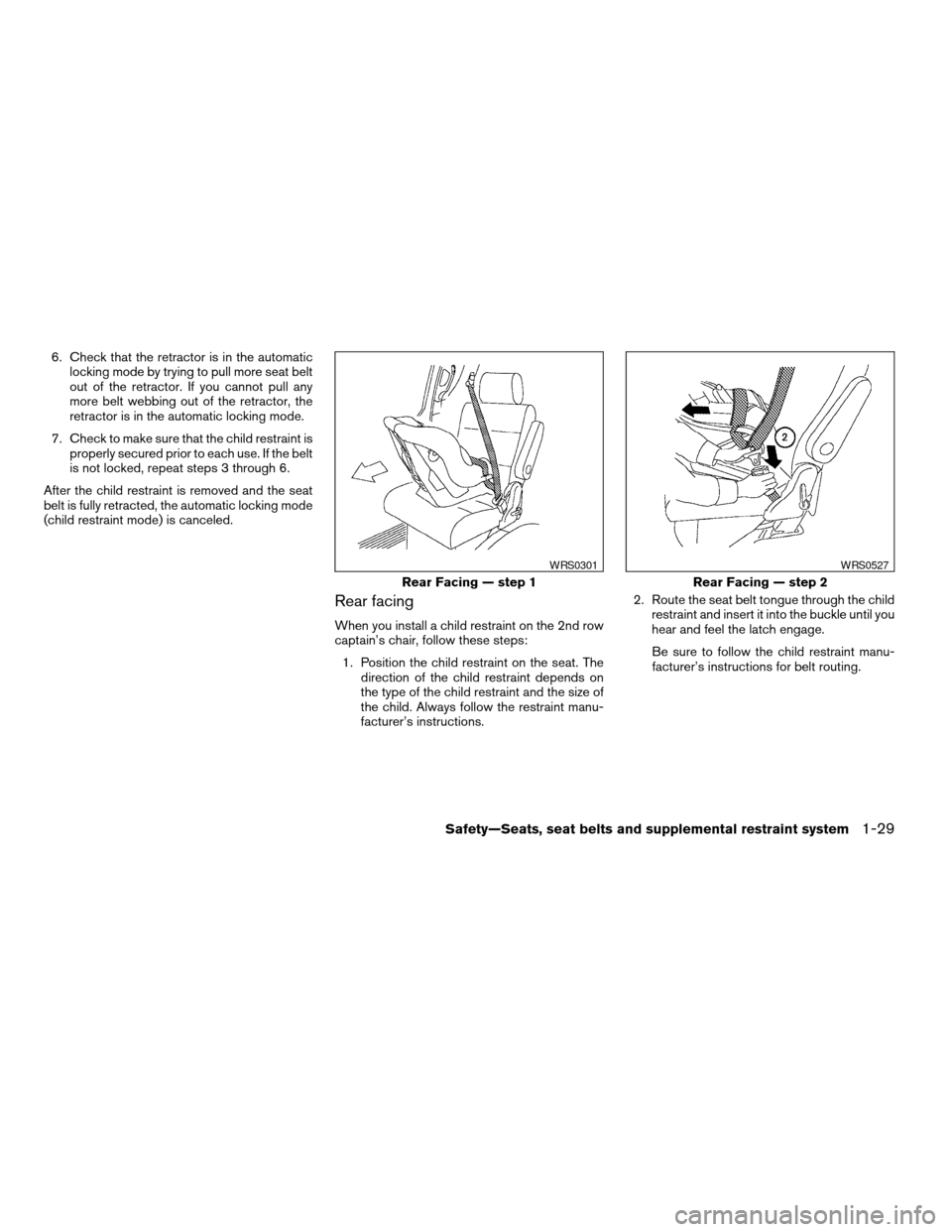
6. Check that the retractor is in the automatic
locking mode by trying to pull more seat belt
out of the retractor. If you cannot pull any
more belt webbing out of the retractor, the
retractor is in the automatic locking mode.
7. Check to make sure that the child restraint is
properly secured prior to each use. If the belt
is not locked, repeat steps 3 through 6.
After the child restraint is removed and the seat
belt is fully retracted, the automatic locking mode
(child restraint mode) is canceled.
Rear facing
When you install a child restraint on the 2nd row
captain’s chair, follow these steps:
1. Position the child restraint on the seat. The
direction of the child restraint depends on
the type of the child restraint and the size of
the child. Always follow the restraint manu-
facturer’s instructions.2. Route the seat belt tongue through the child
restraint and insert it into the buckle until you
hear and feel the latch engage.
Be sure to follow the child restraint manu-
facturer’s instructions for belt routing.
Rear Facing — step 1
WRS0301
Rear Facing — step 2
WRS0527
Safety—Seats, seat belts and supplemental restraint system1-29
ZREVIEW COPYÐ2005 Quest(van)
Owners ManualÐUSA_English(nna)
07/20/04Ðdebbie
X
Page 46 of 328
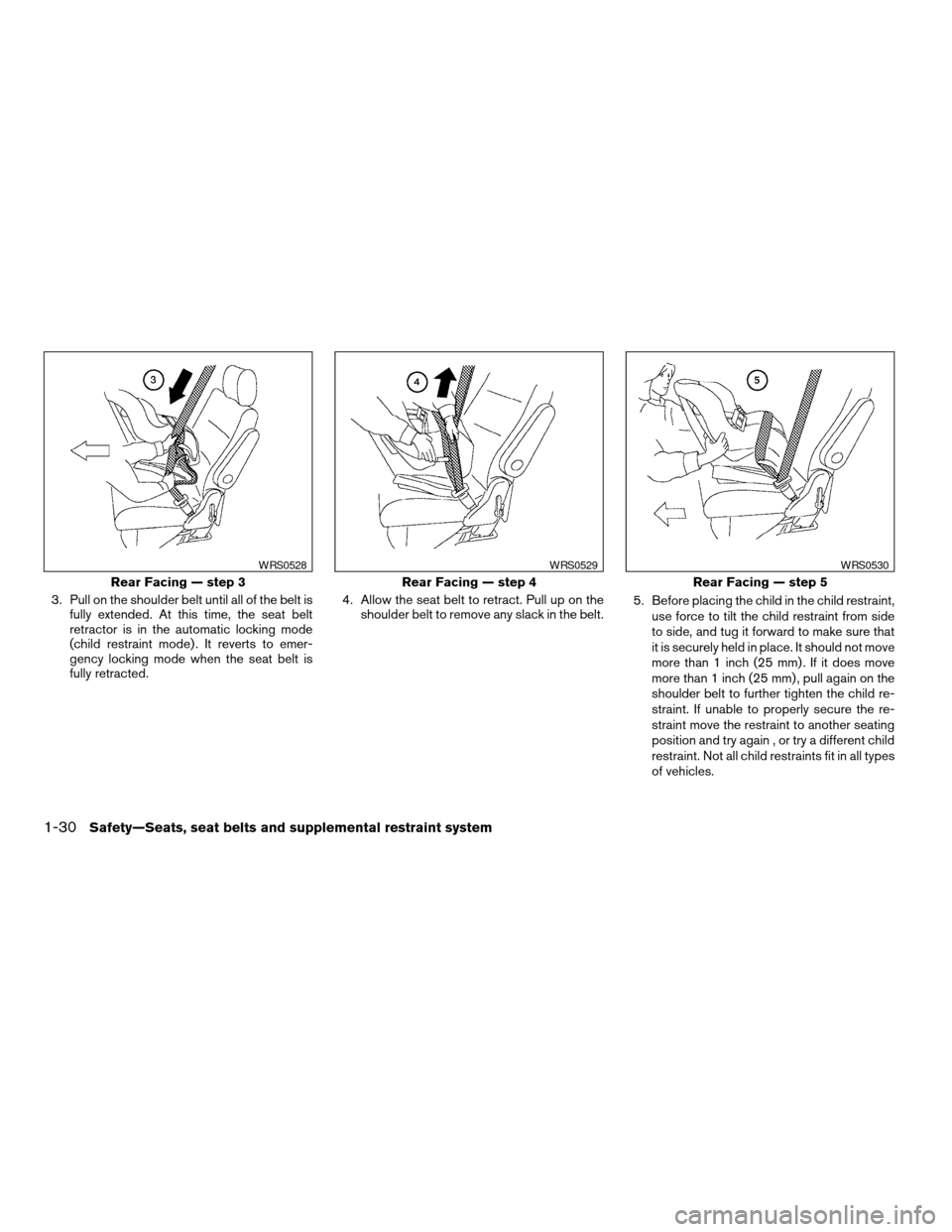
3. Pull on the shoulder belt until all of the belt is
fully extended. At this time, the seat belt
retractor is in the automatic locking mode
(child restraint mode) . It reverts to emer-
gency locking mode when the seat belt is
fully retracted.4. Allow the seat belt to retract. Pull up on the
shoulder belt to remove any slack in the belt.5. Before placing the child in the child restraint,
use force to tilt the child restraint from side
to side, and tug it forward to make sure that
it is securely held in place. It should not move
more than 1 inch (25 mm) . If it does move
more than 1 inch (25 mm) , pull again on the
shoulder belt to further tighten the child re-
straint. If unable to properly secure the re-
straint move the restraint to another seating
position and try again , or try a different child
restraint. Not all child restraints fit in all types
of vehicles.
Rear Facing — step 3
WRS0528
Rear Facing — step 4
WRS0529
Rear Facing — step 5
WRS0530
1-30Safety—Seats, seat belts and supplemental restraint system
ZREVIEW COPYÐ2005 Quest(van)
Owners ManualÐUSA_English(nna)
08/04/04Ðmarlene
X
Page 47 of 328

6. Check that the retractor is in the automatic
locking mode by trying to pull more seat belt
out of the retractor. If you cannot pull any
more seat belt webbing out of the retractor,
the retractor is in the automatic locking
mode.
7. Check to make sure that the child restraint is
properly secured prior to each use. If the belt
is not locked, repeat steps 3 through 6.
After the child restraint is removed and the seat
belt fully retracted, the automatic locking mode
(child restraint mode) is canceled.
CHILD RESTRAINT INSTALLATION
ON 3RD ROW BENCH SEAT
WARNING
cThe three-point seat belt in your vehicle
is equipped with an automatic locking
mode retractor which must be used
when installing a child restraint.
cFailure to use the retractor’s locking
mode will result in the child restraint
not being properly secured. The re-
straint could tip over or otherwise be
unsecured and cause injury to the child
in a sudden stop or collision.cWhen installing a child restraint system
in the rear center position, both the
center seat belt connector tongue and
buckle tongue must be secured. See
“Attaching rear center seat belt” earlier
in this section.
Front facing
WARNING
Front-facing child restraints can be in-
stalled in all 3rd row bench seat positions.
However, front-facing child restraints that
require the use of a top tether strap can be
installed in the center 3rd row position
only. Do not install a child restraint requir-
ing a top tether strap in an outboard posi-
tion and attempt to angle the tether to the
3rd row center anchor.
Front Facing (outboard) — step 1
LRS0357
Safety—Seats, seat belts and supplemental restraint system1-31
ZREVIEW COPYÐ2005 Quest(van)
Owners ManualÐUSA_English(nna)
07/20/04Ðdebbie
X
Page 48 of 328

When you install a child restraint on the 3rd row
bench seat, follow these steps:1. Position the child restraint on the seat. It can
be placed in a front facing direction, de-
pending on the size of the child. Adjust the
head restraint to its highest position. Always
follow the restraint manufacturer’s instruc-
tions. The back of the child restraint should
be secured against the vehicle seat back. If
necessary, adjust or remove the head re-
straint to obtain the correct child restraint fit.
See “Head restraint adjustment” earlier in
this section. If the head restraint is removed,
store it in a secure place. Be sure to install
the head restraint when the child restraint is
removed. If the seating position does not
have an adjustable head restraint and it is
interfering with the proper child restraint fit,
try another seating position or a different
child restraint.2. Route the seat belt tongue through the child
restraint and insert it into the buckle until you
hear and feel the latch engage.
Be sure to follow the child restraint manu-
facturer’s instructions for belt routing.
Front Facing (center) — step 1
LRS0358
Front Facing — step 2
WRS0250
1-32Safety—Seats, seat belts and supplemental restraint system
ZREVIEW COPYÐ2005 Quest(van)
Owners ManualÐUSA_English(nna)
07/20/04Ðdebbie
X
Page 49 of 328

3. Pull on the shoulder belt until all of the belt is
fully extended. At this time, the seat belt
retractor is in the automatic locking mode
(child restraint mode) . It reverts back to
emergency locking mode when the seat belt
is fully retracted.4. Allow the seat belt to retract. Pull up on the
shoulder belt to remove any slack in the belt.5. Before placing the child in the child restraint,
use force to tilt the child restraint from side
to side, and tug it forward to make sure that
it is securely held in place. It should not move
more than 1 inch (25mm) . If it does move
more than 1 inch (25 mm) , pull again on the
shoulder belt to further tighten the child re-
straint. If unable to properly secure the re-
straint move the restraint to another seating
position and try again , or try a different child
restraint. Not all child restraints fit in all types
of vehicles.
Front Facing — step 3
LRS0458
Front Facing — step 4
LRS0457
Front Facing — step 5
WRS0252
Safety—Seats, seat belts and supplemental restraint system1-33
ZREVIEW COPYÐ2005 Quest(van)
Owners ManualÐUSA_English(nna)
08/04/04Ðmarlene
X
Page 50 of 328
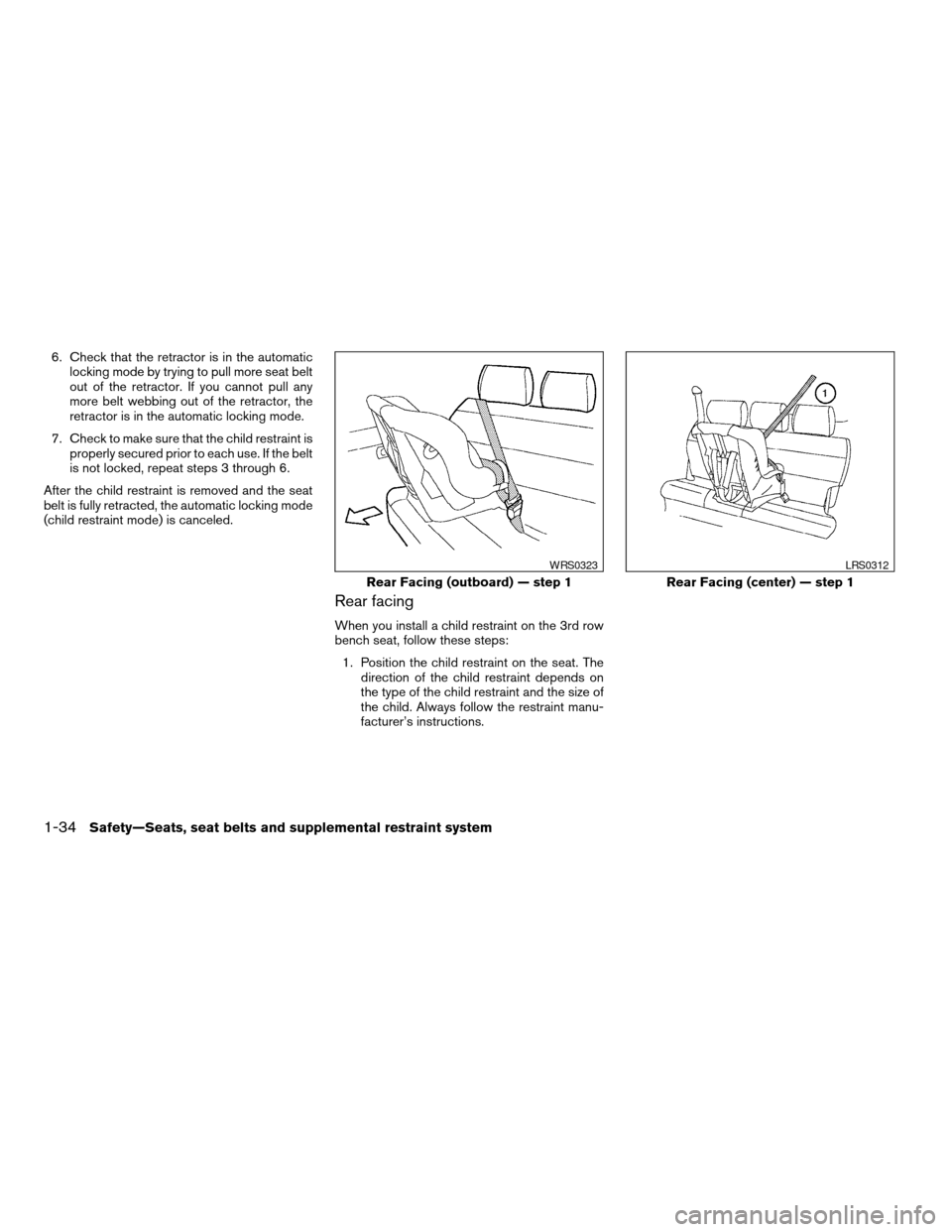
6. Check that the retractor is in the automatic
locking mode by trying to pull more seat belt
out of the retractor. If you cannot pull any
more belt webbing out of the retractor, the
retractor is in the automatic locking mode.
7. Check to make sure that the child restraint is
properly secured prior to each use. If the belt
is not locked, repeat steps 3 through 6.
After the child restraint is removed and the seat
belt is fully retracted, the automatic locking mode
(child restraint mode) is canceled.
Rear facing
When you install a child restraint on the 3rd row
bench seat, follow these steps:
1. Position the child restraint on the seat. The
direction of the child restraint depends on
the type of the child restraint and the size of
the child. Always follow the restraint manu-
facturer’s instructions.
Rear Facing (outboard) — step 1
WRS0323
Rear Facing (center) — step 1
LRS0312
1-34Safety—Seats, seat belts and supplemental restraint system
ZREVIEW COPYÐ2005 Quest(van)
Owners ManualÐUSA_English(nna)
07/20/04Ðdebbie
X